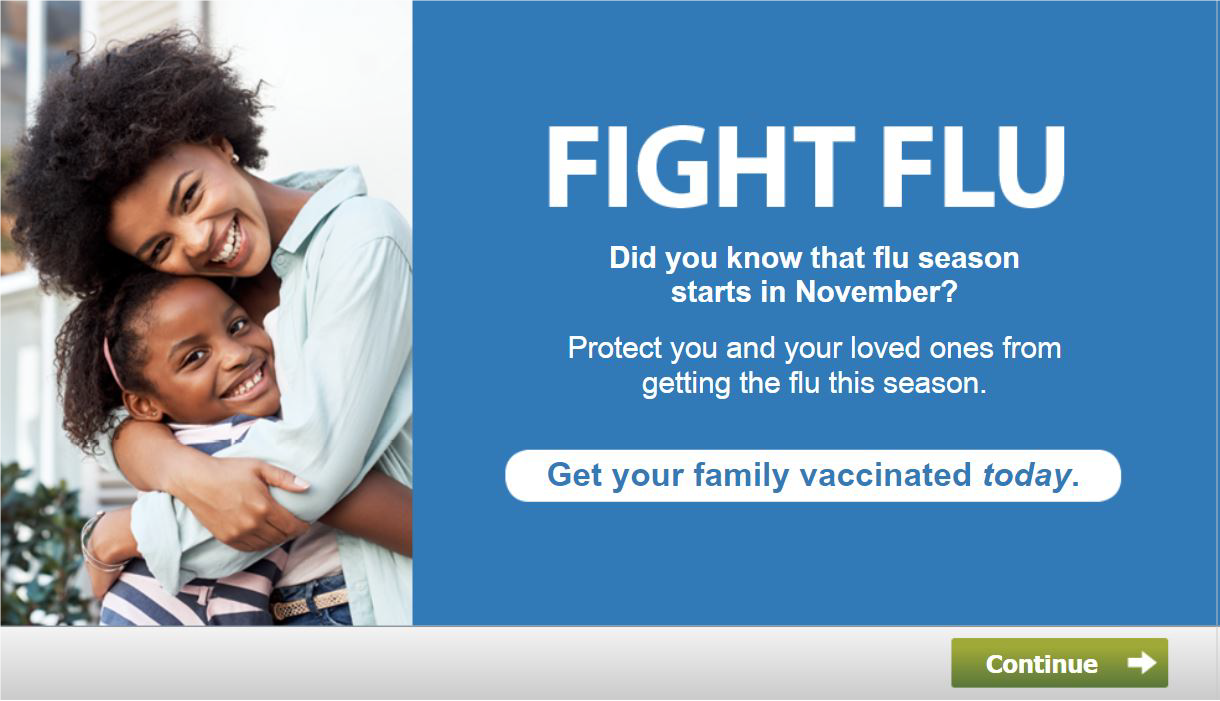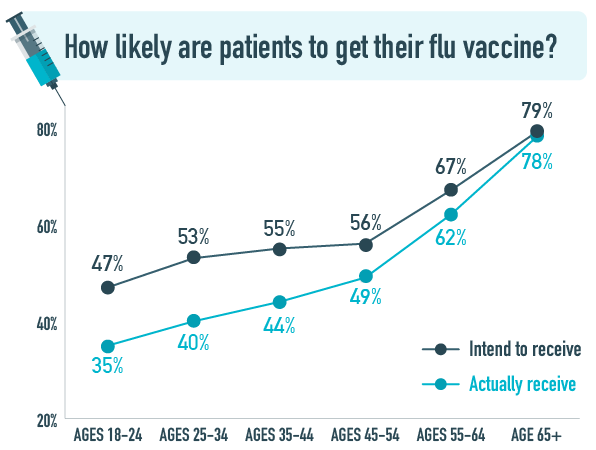The colder weather signals more than just the arrival of the holidays. Flu season is here!
Although anyone can contract influenza at anytime—between 5% and 20% of Americans get the flu at least once a year—it’s no secret that winter weather creates the dangerous conditions that make influenza particularly contagious.
For example, during the 2017-2018 flu season, the Centers for Disease Control (CDC) estimated that more than 900,000 people were hospitalized, and more than 80,000 people died from the flu, including 185 children. Patients age 65 and older represented approximately 58% of influenza hospitalizations during that season.
Given the potentially devastating effects of the flu, it’s no surprise that the vaccine is recommended for everyone starting at age 6 months. During the 2016-17 flu season, the vaccine prevented an estimated 5.3 million illnesses, 2.6 million medical visits and 85,000 flu-associated hospitalizations.
Still, healthcare organizations continue to face challenges with effectively conveying the risks of influenza to patients and motivating them to get their annual flu shot. But without knowing key data points—such as what percentage of patients actually get the flu vaccine, which patient groups are most likely to get their flu vaccines, and where they prefer to get vaccinated—it will be difficult for providers to improve their outreach and set realistic goals.
To help address that information gap, our research team, Phreesia Patient Insights, showed more than 16,000 patients a short message about the importance of getting a flu vaccine, and then asked them to complete a short survey.

*Phreesia created this content using previously posted materials from the U.S. Centers for Disease Control and Prevention.
Here’s what the survey responses revealed:
As patients get older, they are more likely to get their annual flu vaccine
Overall, 58% of surveyed patients said they get their flu vaccine every year. However, that number jumps to 78% among patients age 65 and older, which could be attributed to several factors, including providers’ efforts to push vaccination among older patients because of their increased risk of severe flu.
- 35% of patients ages 18 to 24 get a flu vaccine every year
- 40% of patients ages 25 to 34 get a flu vaccine every year
- 44% of patients ages 35 to 44 get a flu vaccine every year
- 49% of patients ages 45 to 54 get a flu vaccine every year
- 62% of patients ages 55 to 64 get a flu vaccine every year
- 78% of patients age 65 and older get a flu vaccine every year
On average, nearly two-thirds of patients said they were very likely to get a flu vaccine this year
Across age groups, the number of patients who actually get their flu vaccine—58% of patients overall—is lower than the 65% of patients who say they plan to receive it. The exception to this is among patients age 65 and older. Seventy-nine percent of patients 65+ reported that they were very likely to get their flu vaccine this year, which is roughly the same as the 78% of patients in that age group who say they get their flu vaccine.
- 47% of patients ages 18 to 22 are very likely to get a flu vaccine this year
- 53% of patients ages 23 to 34 are very likely to get a flu vaccine this year
- 55% of patients ages 35 to 44 are very likely to get a flu vaccine this year
- 56% of patients ages 45 to 54 are very likely to get a flu vaccine this year
- 67% of patients ages 55 to 64 are very likely to get a flu vaccine this year
- 79% of patients age 65 and older are very likely to get a flu vaccine this year

Patients are open to receiving their flu vaccine at other locations besides their doctor’s office
According to Phreesia’s survey, patients aren’t looking exclusively to their healthcare providers to get their flu vaccine. However, it is still the most popular option.
- 33% of patients intend to get their flu shot at their doctor’s office.
- 20% of patients intend to get their flu shot at a drug store or pharmacy. Within that group, nearly one-third of of patients age 65 and older intend to get their flu shot at one of those locations.
- 13% of patients ages 25 to 64 intend to get their flu vaccine at work.
Most patients haven’t received their flu vaccine yet
Flu season begins in November and can last until as late as May, with the peak number of illnesses occurring between December and February. When Phreesia Patient Insights conducted the survey in November 2019, 10% of respondents across all age groups had received their flu vaccine, and 13% of patients age 65+ had already been vaccinated.
Prompting patients to get the flu vaccine works
Phreesia’s survey data shows that when patients are shown short, engaging content, they’re more motivated to talk to their healthcare provider about getting the flu vaccine. When asked about the flu vaccine content they saw, 39% of patients said it was very motivating compared to other content they had seen.
- Among those patients who reported being most motivated by the flu prevention content, 91% said they intended to get their flu vaccine this flu season, and 78% said they planned to talk to their doctor about getting a flu vaccine.
- Among those who reported being very motivated by the content, 3 in 4 said they get their flu vaccine annually.
Every year, people of all ages, and particularly older adults, are at risk of contracting the flu, especially during the winter months. This flu season will be no different. It’s imperative that healthcare organizations engage with their patients and educate them on the importance of getting vaccinated.
Learn how Phreesia Health Campaigns can help you target specific patients and prompt them to get preventive-care services, including flu vaccines.





